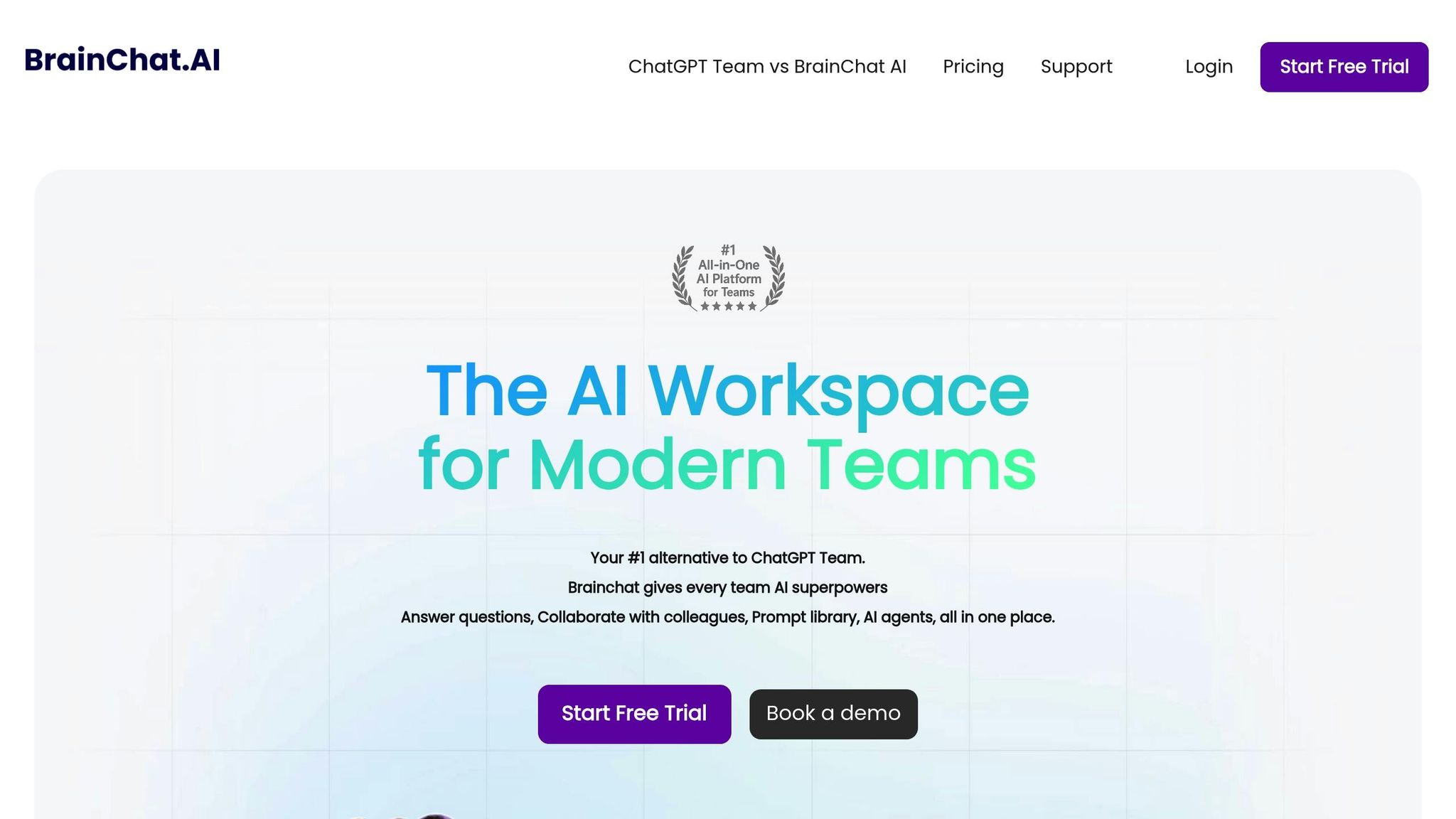
High AI Costs Draining Budget? 5 Smart Solutions

AI tools can be expensive, but there are practical ways to manage costs without sacrificing performance. Here's how businesses can tackle rising AI expenses:
- Use Open-Source Tools: Platforms like TensorFlow, PyTorch, and Hugging Face offer free, customizable solutions that eliminate licensing fees and provide flexibility.
- Audit and Streamline Workflows: Review current AI tools, remove redundancies, and automate repetitive tasks to save time and resources.
- Improve Data Management: Reduce storage costs by eliminating duplicates, optimizing pipelines, and maintaining high data quality for better results.
- Opt for Clear Pricing Models: Choose platforms with transparent pricing, such as BrainChat.AI, which offers fixed per-user rates and tools to control spending.
- Invest in Internal Skills: Train employees to reduce reliance on external consultants and leverage open-source communities for free resources.
How We Cut $10K+ in Costs Using AI: Real Founder Stories (Website, Marketing & More)
Use Open-Source AI Tools and Frameworks
If you're looking to cut AI costs without sacrificing performance, open-source AI tools and frameworks are a fantastic option. They eliminate pricey licensing fees, offer customizable fine-tuning for specific industry needs, and ensure consistent, reproducible results. These tools also shine in industries where compliance and transparency are critical, making them a practical, cost-effective solution that fits seamlessly into existing workflows.
By leveraging open-source platforms, businesses can sidestep the high costs associated with proprietary models while maintaining flexibility and control over their AI systems.
Top Open-Source AI Platforms for Businesses
Here are some of the most widely used open-source platforms in U.S. enterprises, each with its own strengths:
- TensorFlow: A powerhouse for large-scale machine learning projects, TensorFlow is known for its enterprise-grade capabilities and smooth integration with major cloud services.
- PyTorch: Preferred by research-driven teams, PyTorch is highly flexible and supports rapid experimentation with its dynamic computational graph functionality.
- Hugging Face Transformers: Specializing in natural language processing, this library offers pre-trained models that make it easy to deploy text analysis and conversational AI solutions.
- Microsoft Agent Framework: Ideal for building complex multi-agent systems, this framework provides an open-source SDK and runtime, combining enterprise reliability with advanced orchestration features.
How to Implement These Tools
To successfully integrate open-source AI tools into your business, start by identifying specific challenges they can address. For instance, if your customer service team is inundated with repetitive queries, you could deploy a chatbot using Hugging Face Transformers to handle these tasks efficiently, reducing both workload and costs.
Most open-source tools can be integrated into existing systems via APIs or containerized deployments, allowing teams to experiment without disrupting current operations. Fine-tuning models with your company’s unique datasets ensures that outputs are tailored to your needs. This level of control also enables internal teams to inspect models, conduct audits, and ensure compliance with industry regulations - critical for maintaining trust and transparency.
Open-Source Framework Comparison
Choosing the right framework depends on your specific goals and the technical expertise of your team. Here's a quick comparison:
| Framework | Best Use Cases | Remarks |
|---|---|---|
| TensorFlow | Large-scale machine learning and production systems | Enterprise-grade platform with strong integration capabilities |
| PyTorch | Research, rapid prototyping, and computer vision | Flexible framework for dynamic computation and quick experimentation |
| Hugging Face Transformers | Natural language processing and conversational AI | Robust library of pre-trained models for fast and effective deployment |
| Microsoft Agent Framework | Multi-agent systems and complex workflows | Advanced orchestration with an open-source SDK and runtime |
For production environments demanding stability and scalability, TensorFlow is a solid choice. PyTorch is better suited for research and development due to its agility. Hugging Face simplifies deployment for language-based applications, while Microsoft Agent Framework excels in managing complex, multi-agent workflows.
Improve and Streamline Current AI Workflows
Before diving into new AI investments, take a step back and evaluate your current setup. Inefficient workflows, overlapping tools, and disorganized data can quietly drain resources. By refining your existing AI operations, you can often cut costs and improve efficiency without the need for major upgrades or additional technology.
The first step? A thorough audit. This process can uncover areas where resources are being wasted, offering opportunities to save money and potentially boost performance. Once you've identified inefficiencies, focus on automating repetitive tasks to streamline operations.
Review and Assess Current AI Tools
Start by cataloging all the AI tools, subscriptions, and services your organization uses. This includes everything from large enterprise software licenses to smaller team-specific tools that may have slipped under the radar. Look for duplicate tools and unused subscriptions that are unnecessarily adding to your costs.
Perform a cost-benefit analysis for each tool, factoring in expenses like licensing, training, and maintenance. Compare these costs against actual usage and the measurable impact on your business. For example, you might discover that a costly enterprise platform is only being used for simple tasks that could easily be handled by a less expensive alternative.
Eliminate redundancies and underutilized tools. If multiple teams are using similar tools, consolidate their subscriptions. Likewise, if a tool is licensed organization-wide but only used by a handful of employees, consider downsizing or replacing it.
Document the business outcomes each tool delivers. Tools that fail to show a clear return on investment or measurable improvements in productivity should be targeted for removal. This process often reveals that a surprising number of AI subscriptions provide little value and can be canceled without disrupting operations.
Use Automation to Cut Costs
Automation is a powerful way to reduce costs while increasing efficiency. By automating repetitive tasks, you can save both computational resources and employee time, allowing your team to focus on higher-value activities.
Focus on automating key areas like data preprocessing, model deployment, and results processing. Manual data preparation can be a major time sink, so automating tasks like data cleaning, feature extraction, and model retraining can lead to significant savings. Additionally, schedule non-critical tasks to run during off-peak hours to lower costs even further.
Leverage automated scaling to control computing expenses. This ensures you only pay for the resources you need, exactly when you need them.
Better Data Management
Once you've optimized your tools and automated workflows, turn your attention to data management. Poor data practices are often a hidden driver of high AI costs. Unnecessary data duplication, inefficient storage, and poorly designed pipelines can inflate both storage and computational expenses.
Start by auditing your data storage systems. Implement lifecycle management policies to archive or delete outdated data and establish clear retention guidelines for different types of information. This can help reduce storage costs while improving system performance.
Streamline your data pipelines to cut down on processing expenses. Use efficient file formats like Parquet instead of uncompressed CSVs, compress data where possible, and eliminate redundant transformations. These changes can make a noticeable difference in both storage and processing time.
Smart caching can also be a game-changer. By caching frequently used data, you can avoid repetitive processing, cutting down on computational costs and speeding up results.
Finally, invest in data quality monitoring. Poor-quality data forces AI systems to work harder, consuming more resources to deliver acceptable outcomes. By maintaining high data quality standards, you can achieve better results with fewer resources, saving both time and money in the long run.
Choose Scalable, Clear Pricing Models
When selecting AI platforms, steer clear of hidden fees and unpredictable usage-based billing. Opt for pricing models that scale with your needs without locking you into expensive contracts. Clear, scalable pricing not only simplifies budgeting but also complements the streamlined AI workflows we touched on earlier.
By combining transparent pricing with efficient workflows, businesses can enhance cost management while ensuring their AI tools grow alongside their needs.
BrainChat.AI's Straightforward Pricing Options

BrainChat.AI tackles pricing concerns with an easy-to-understand tiered structure tailored to businesses at different stages of growth.
- Starter Plan: At $7 per user per month, this plan is ideal for small teams. It includes essential features like access to OpenAI models, usage reports, shared folders, and prompt libraries. The plan supports up to 50 members per organization, with a minimum requirement of 5 users.
- Business Plan: For expanding businesses, this plan costs $10 per user per month and offers enhanced capabilities. Users gain access to multiple AI models (not just OpenAI), advanced reporting tools, and higher file upload limits. Teams also benefit from 20 AI agents (compared to 3 in the Starter plan) and 200 file uploads per user (versus 20 in the Starter tier).
- Enterprise Tier: Designed for large organizations, this option provides custom pricing based on specific needs. Features include unlimited workspaces, private cloud deployment, dedicated account management, custom integrations, and advanced security protocols. This ensures companies only pay for the features they require.
With fixed per-user rates, businesses can easily forecast expenses as their teams grow, eliminating the guesswork from budget planning.
Budget Management Features
Transparent pricing is just the beginning. BrainChat.AI also offers tools to help businesses control costs effectively:
- Analytics Dashboards: These provide detailed insights into team AI usage, tracking metrics like model usage, file uploads, and workspace activity. By identifying usage trends, businesses can better manage their AI-related expenses.
- Admin Controls: Managers can set usage limits to prevent unexpected overages. Admins can establish spending boundaries, ensuring budgets stay on track.
- Detailed Usage Reports: Reports can be broken down by team, department, or project, giving organizations a clear picture of which areas are driving AI costs and whether those investments are yielding results.
This proactive approach to cost management is especially beneficial for U.S. businesses operating under strict budgetary guidelines.
Why This Approach Fits U.S. Businesses
The pricing and budget management tools offered by BrainChat.AI align perfectly with the needs of U.S. businesses. Predictable billing and clear cost structures resonate with finance teams and fit seamlessly into existing budget frameworks. The fixed per-user pricing mirrors familiar software subscription models, making it easier to gain approval from stakeholders.
Flexibility is another key advantage. U.S. businesses often require the ability to adjust team sizes without penalties or complicated contract renegotiations. BrainChat.AI allows companies to scale up during busy periods or scale down during slower times without being locked into rigid annual commitments that don’t align with their operational realities.
For many American businesses, starting small and scaling gradually is a preferred way to adopt new technology. The Starter plan provides an affordable entry point, allowing companies to test the waters, prove value, and upgrade as their needs grow. This approach minimizes risk and makes it easier to demonstrate ROI to decision-makers who may be hesitant about AI investments.
Additionally, transparent pricing simplifies compliance with procurement processes. When costs are clear and predictable, navigating approval workflows and meeting financial controls becomes much more straightforward, ensuring a smoother integration of AI tools into the business.
sbb-itb-f296c05
Focus on Privacy and Security to Avoid Hidden Costs
Cutting corners on AI security can lead to hefty expenses for businesses. Data breaches often result in regulatory fines, legal battles, customer compensation, and lasting damage to a company's reputation.
Meeting U.S. Compliance Requirements
In the U.S., certifications like SOC 2 Type 2 have become critical benchmarks for evaluating AI platforms. This certification confirms that a service provider has implemented stringent controls over security, availability, processing integrity, confidentiality, and privacy - factors that are closely scrutinized during enterprise procurement processes.
For companies interacting with European customers or partners, GDPR compliance remains essential. Similarly, healthcare organizations must adhere to HIPAA regulations to avoid severe penalties for mishandling sensitive data.
BrainChat.AI tackles these challenges head-on by maintaining SOC 2 Type 2 certification and adopting GDPR-compliant data handling protocols. This streamlined approach spares businesses the hassle of investing in additional compliance tools or legal consultations while ensuring that their AI systems meet critical regulatory standards.
But compliance is just one piece of the puzzle. The right deployment model can also help businesses sidestep unexpected security costs.
Private Cloud and Self-Hosted Options
Even with compliance in check, deployment strategies play a key role in controlling costs. Public cloud AI services often come with hidden security-related expenses - like charges for data transfers, compliance audits, or third-party risk assessments. Private cloud deployments, on the other hand, help minimize these costs by keeping sensitive data within a controlled environment. This setup provides better visibility over data flows and can significantly reduce security expenses.
BrainChat.AI’s Enterprise tier offers private cloud deployment, enabling organizations to run AI workloads on dedicated infrastructure. For those seeking even greater control, self-hosted options allow businesses to manage their own encryption standards, access controls, and monitoring systems - avoiding the premium fees typically associated with cloud provider security features.
Many companies have reported substantial savings by migrating from multi-tenant cloud services to private or self-hosted solutions, particularly by cutting down on compliance monitoring and external audit expenses.
Preventing Data Breach Costs
A secure deployment strategy is also key to avoiding the steep costs associated with data breaches. Measures like advanced encryption, zero-trust architecture, and multi-factor authentication (MFA) provide robust defenses against unauthorized access and reduce overall security risks.
- Advanced encryption, such as AES-256, ensures that even if data is compromised, it remains unreadable without the proper decryption keys.
- Zero-trust architecture continuously verifies every access request, significantly lowering the chances of unauthorized access.
- Multi-factor authentication (MFA) bolsters password-based systems, dramatically reducing the likelihood of automated attacks.
BrainChat.AI incorporates end-to-end encryption for all data transmissions and storage, safeguarding sensitive business information throughout the AI processing lifecycle. The platform also includes advanced access controls, allowing administrators to assign specific permissions based on user roles and data types.
Additionally, real-time monitoring and anomaly detection enhance security by identifying potential threats before they escalate. High-profile breaches have demonstrated that investing in robust preventative measures is often far more affordable than dealing with the financial fallout of insufficient security. BrainChat.AI’s security features provide businesses with peace of mind, knowing their data is protected at every stage.
Build Internal AI Skills and Knowledge
Developing internal AI expertise not only reduces expenses but also boosts long-term efficiency. By focusing on in-house skills, teams can extract more value from existing AI tools instead of constantly searching for new solutions, making it a smart and cost-effective strategy.
Internal AI Training Programs
Investing in employee training is a great way to cut down on external consulting fees. Create role-specific, hands-on training programs, encourage peer mentorship, and document best practices to build a strong foundation of AI knowledge within your team.
Tools like BrainChat.AI's shared folders make it simple to store and organize these resources, ensuring they’re easily accessible across the team.
Join Open-Source Communities
Open-source AI communities are treasure troves of free knowledge, tools, and peer support. These communities often provide resources and insights that could cost thousands of dollars through traditional training programs.
Platforms like TensorFlow, PyTorch, and Hugging Face on GitHub offer tutorials, tools, and collaborative opportunities. Engaging with these communities can save both time and money, as they often lead to faster problem-solving and reduced development costs.
Share Knowledge Across Teams
When teams share AI knowledge across departments, the benefits multiply. This approach not only avoids duplicate training costs but also speeds up company-wide adoption of AI.
Encourage collaboration by forming cross-functional AI groups, using shared libraries for prompts and workflows, and hosting regular knowledge-sharing sessions. BrainChat.AI's collaboration tools can help teams create repositories of effective prompts, automation workflows, and best practices.
Additionally, establish clear documentation standards for AI projects. This ensures that knowledge stays accessible even when team members move to new roles, preventing costly re-learning and keeping AI investments productive over time.
Conclusion: Managing AI Costs While Maintaining Performance
Cutting AI costs doesn’t have to come at the expense of performance or progress. The strategies outlined earlier show that businesses can reduce expenses while still advancing their AI capabilities.
For instance, companies that implement effective MLOps practices have reported 40% reductions in costs for managing the ML lifecycle and an impressive 97% boost in model performance. This clearly demonstrates that strategic cost management can go hand in hand with better results.
Adopting open-source AI solutions further supports cost-effective advancements, offering the kind of flexibility and transparency that modern businesses value.
To recap, embracing adaptable and budget-conscious methods gives businesses more control, customization options, and freedom from restrictive vendor contracts. By leveraging open-source tools, optimizing workflows, ensuring transparent pricing, prioritizing security, and building internal expertise, companies can establish a solid framework for long-term AI success.
With the global AI market projected to reach $900 billion by 2026, growing at an 18.6% annual rate, the organizations that excel will be those that balance innovation with cost efficiency. The strategies shared here equip you to achieve that balance, keeping your AI investments impactful and affordable.
Focus on solutions that offer flexibility, scalability, and clear pricing structures. This approach not only adapts to changing demands but also avoids the pitfalls of costly vendor lock-ins. By integrating these strategies, businesses can turn AI challenges into opportunities for sustainable growth.
FAQs
What’s the best way for businesses to adopt open-source AI tools without disrupting their current workflows?
To make the transition to open-source AI tools as smooth as possible, businesses should focus on selecting tools that work well with their current systems. Ensuring compatibility helps avoid unnecessary disruptions and makes the integration process much easier. It’s also important to offer employees focused training, so they can quickly get up to speed with the new tools and workflows.
Another key step is keeping human oversight in place for AI-driven operations. This helps ensure decisions align with the company’s objectives and reduces the chance of mistakes. A smart approach is to start small - test these tools in specific areas first. Once they prove effective, you can expand their use gradually without overwhelming your existing processes.
What are the advantages of using AI platforms with transparent pricing, and how can they help manage a company's budget effectively?
Using AI platforms with clear pricing models comes with several benefits. For starters, it helps businesses plan their budgets more accurately, steer clear of surprise charges, and manage resources effectively. This level of clarity gives companies better financial oversight, making it easier to adopt AI solutions without stretching their budgets.
It also encourages smarter choices by allowing businesses to focus on cost-efficient strategies that deliver the best value. When companies know exactly what they’re paying for, they can make informed plans, stick to their financial goals, and get the most out of AI tools to boost productivity and profitability.
Why should companies focus on building internal AI expertise, and how does it help reduce reliance on external consultants?
Building internal AI expertise is a game-changer for companies. It empowers businesses to operate independently, trim expenses, and respond more swiftly to challenges. By cultivating in-house talent, organizations can create AI solutions tailored to their unique goals and values, ensuring a perfect fit and quicker implementation.
Having an internal team also means significant cost savings. Automating processes reduces reliance on expensive external consultants, leading to long-term financial benefits. Plus, an in-house team allows companies to pivot quickly and efficiently when project demands shift in the fast-paced world of AI.
Related Blog Posts
Turbocharge your team with BrainChat AI
Teams using BrainChat report a 40% boost in task completion speed. Imagine what your team could achieve.
%20(1).png)


